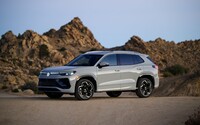Volkswagen had a problem — one of its own making.
It had a very successful small crossover — the Tiguan — that was the only German-brand crossover in its class. The Tiggy has always been a little more upmarket-feeling than the other crossovers in the compact crossover class, which were (and still are) Japanese, Korean and American.
Then VW brought out the Taos, which was very close to the Tiggy in many ways — except in price. It cost thousands less than the Tiggy and so pirated sales away from the Tiggy.
Its success came at the expense of the Tiggy's.
The fix?
Put some distance — between the Tiggy and the Taos.
What It Is
The Tiguan can be described as a compact-luxury crossover lacking only the badge (and price to go with) of a comparable Audi, Mercedes or Lexus small crossover. It is a little larger than the Taos — which is also a compact crossover — but what separates the two is what you can get for the money.
The Tiggy — which stickers for $31,670 to start for the S trim (versus $25,495 for the Taos) — comes standard with a larger, more powerful engine than is available in the Taos, a fully digital (LCD) 10.25-inch main gauge cluster and an even larger 12.9-inch secondary LCD screen. It can be optioned with features such as quilted leather upholstery and massaging seats; these high-end features are not available with the Taos.
In addition to the base S trim, there are also SE ($34,470), SE R-Line Black ($37,640) and top-of-the-line SEL R-line ($41,930) trims. The latter comes standard with the all-wheel drive that's optional with the other three trims, plus adaptive headlights that turn with you in the curves, the seat massagers, 20-inch wheels, a heads-up display and a panorama sunroof.
What's New for 2025
The 2025 Tiggy has been heavily updated for the new model year.
What's Good
— Clear separation between the Tiggy and the Taos has been established.
— Base S trim is much less expensive than small, luxury-brand crossovers such as the $39,800 to start Audi Q3 yet compares favorably with them on the merits.
— Available massaging seats are an impressive feature to find in a vehicle with a price tag under $60,000.
What's Not So Good
— Previously available third-row option has been dropped.
— While the output of the standard engine has been increased, a bit more power (and performance) would put more separation between the Tiggy and the Taos.
— While cargo space behind the second row has been increased (by getting rid of the third-row option) total cargo-carrying capacity is less than it was previously.
Under the Hood
The Tiggy has always had a larger standard engine — a turbocharged 2.0-liter four — than the Taos, which comes with a 1.5-liter four. The problem — for the Tiggy — was that its larger, 2.0-liter four hardly made more power — 184 horsepower — than the 174 horsepower made by the smaller engine in the Taos.
VW has just remedied that by upping the output of the '25 Tiggy's still-standard 2.0-liter four to a more appropriate 201 horsepower. However, even with the larger engine and more on-paper power, the Tiggy isn't quicker than the Taos. Each of these small crossovers takes about eight seconds to accelerate to 60 mph.
The Tiggy's 2.0-liter engine is paired with an eight-speed automatic and either front-wheel drive or AWD. There are driver-selectable modes, which alter the feel of the engine's responsiveness. Gas mileage with the FWD version of the Tiggy is 26 mpg city, 34 mpg highway; with AWD, it decreases significantly, to 22 mpg city, 30 mpg highway.
You can hitch a small trailer to the Tiggy, which is rated to pull up to 1,800 pounds (FWD models). AWD models are rated to pull up to 1,500 pounds.
On the Road
The new Tiggy is built on the same EQB Evo platform as the current Golf GTI, and that imparts noticeable athleticism — in terms of handling. It tracks where you point it, without feeling lurchy.
What's lacking is the power to go with it.
When you're just driving, it's not noticeable, as the 2.0-liter four is a torquey and smooth engine, and it has enough power to keep up with traffic without feeling as if it's struggling to keep up. But when you floor it from a dead stop, there's a momentary lag before the Tiggy's engine responds, so you kind of lose a step before you begin. Passing power is adequate, but the Tiggy deserves better than that. Put another way, a near-luxury crossover like the Tiggy ought to easily outpace an entry-level crossover like the Taos. The soon-to-be-available Turbo R-Line version of the Tiggy will do that, but its performance will likely cost well over $40,000.
At the Curb
The '25 Tiggy is the largest — the longest — Tiggy so far. It's 184.1 inches end to end and so about 6 inches longer than the Taos, which is 175.9 inches long. Both are still within the parameters of the compact class, however.
What makes the Tiggy different is its now noticeably higher-end ambience inside. The "digital cockpit" treatment that was offered on higher trims previously is now standard and has been upgraded with a larger 10.25-inch main instrument panel with an even larger, almost 13-inch secondary panel to its right. The SEL R-Line gets an upgraded 15-inch secondary screen with rich-looking, almost 3D graphics.
One of the smart design features of the latter is large font displays for such things as the radio station you're listening to (and so on) that make it easier to read at a glance, which helps you keep your eyes on the road. There is also an integrated mood-lighting system that can be tailored to suit your preferences, along with what appear to be real wood trim inserts. If you removed the "VW" badge on the steering wheel hub and replaced it with the Audi discs or the Mercedes three-pointed star, nothing would seem incongruous.
But the previously available third row is gone.
The decision to nix this useful and unusual-in-this-class option is interesting because it eliminates an available feature that the Taos never offered and that very few other compact crossovers do, either. The Tiggy's previously available third row was not exactly spacious, but it did give this compact crossover the capability to transport up to seven people.
The Rest
VW might have given some thought to making some of the standout luxury items that are standard in the SEL R-Line such as the massaging front seats and heated rear seats as well as the excellent 12-speaker Harmon Kardon audio system available as options in at least some of the other trims. But if you want any of the just mentioned, you have to spring for the top-of-the-line SEL R-Line. Given all you get, it's still a relative bargain versus the equipment-equivalent crossovers with luxury-brand badges — but it'd really take the wind out of the sails of those luxury-brand crossovers if similar equipment were available in a VW that could be purchased for, say, $35,000 or so.
The Bottom Line
The new Tiggy puts some much-needed distance between itself and the Taos in every way except as measured by the stopwatch.
Eric's latest book, "Doomed: Good Cars Gone Wrong!" will be available soon. To find out more about Eric and read his past columns, please visit the Creators Syndicate webpage at www.creators.com.
View the Volkswagen Tiguan this week.







View Comments